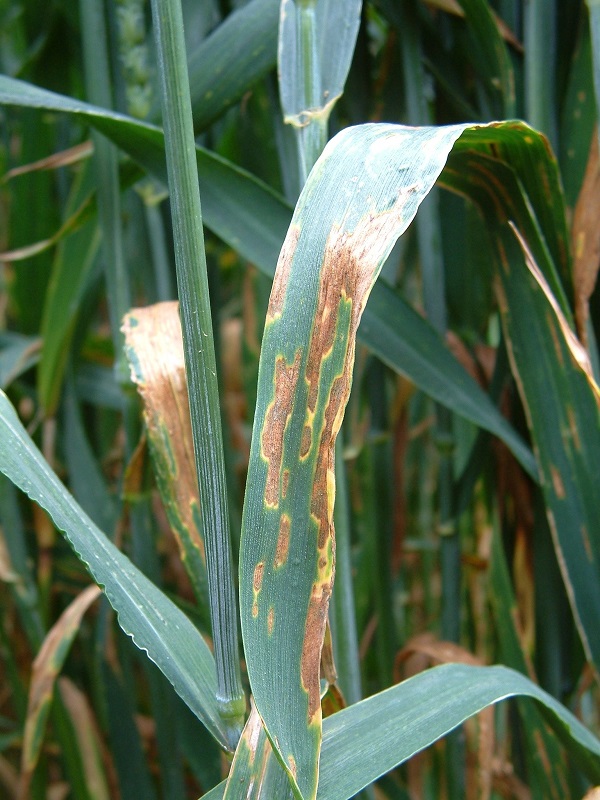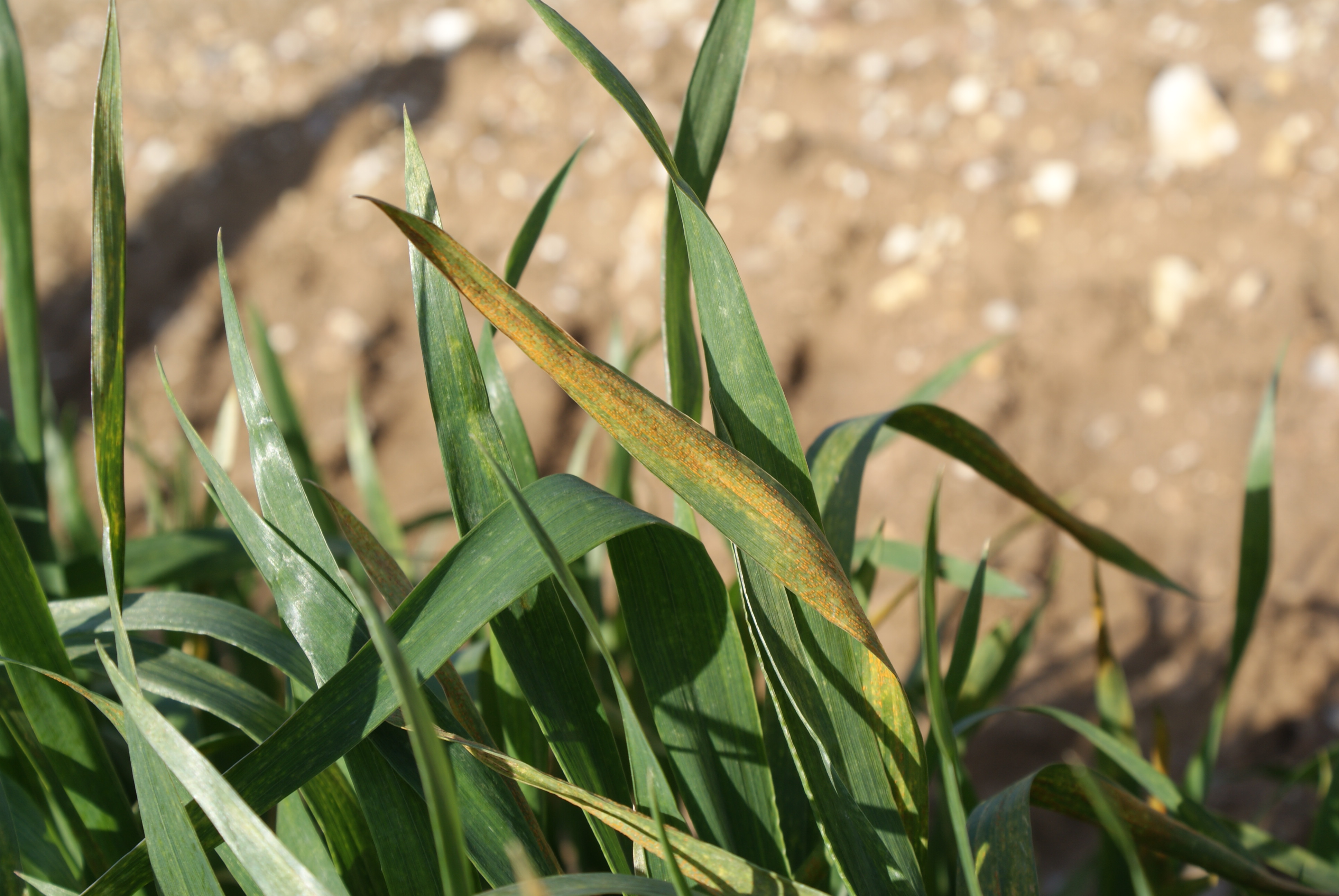After a topsy-turvy spring that’s compromised some early fungicide timing, adequately protecting the flag leaf at T2 has never been more important. CPM canvasses some advice.
There’s lots of septoria in crops, not surprising given how wet it’s been.
By Lucy de la Pasture
This spring has created a bit of a catch twenty-two situation. The cold, wet winter and a similar start to spring may have reduced some early disease pressure but it’s also made travel difficult in many areas, compromising early spray timings.
Cutting back early sprays unnecessarily risks allowing disease to establish and could put later applied chemistry under extra pressure, says Hutchinsons’ technical development director, Dr David Ellerton.
The difficulty in the field is that in many situations the T0 had to be abandoned because, at the correct timing, the sprayer wasn’t able to travel. It’s a position Herefords agronomist and AICC member David Lines found himself in, with only 16ha of his planned T0 sprays actually applied due to the tricky weather.
In his region most winter wheat crops have achieved plenty of biomass, he says, with only some of the later-drillled fields looking less than well tillered. “Most of my wheat acreage is down to varieties with relatively good septoria resistance, such as Graham, Shabras, Costello, KWS Siskin and Skyfall.

Septoria is the main target in crops this year, especially where T0 sprays weren’t applied.
“Septoria is the main target so T1 recommendations have needed to be relatively robust, with plenty of septoria visible on the lower leaves of crops. On the more reisistant varieties T1 was based around older SDHI, Vertisan (penthiopyrad) plus epoxiconazole at 0.7-0.85 l/ha plus 1.0 l/ha chlorothalonil (CTL).”
For his dirtier varieties, such as Elation, he’s opted for the newer SDHI, Adexar (epoxiconazole+ fluxapyroxad) plus CTL at T1.
David Lines’ view is there was little point in applying a late T0 because, with crops racing through their growth stages in the warm spell during mid-April, this approach may well have compromised the timing of T1. He’s pretty confident most of his T1s have been applied as leaf three emerges, along with a modified PGR programme where he’s recommended a low rate of Moddus (trinexapac-ethyl) at 0.1 l/ha accompanies the chlormequat that didn’t go on at T0.
“In the next few weeks it’ll become apparent how well the T1s have worked. At the time of application leaf four only had a bit of septoria at the tip but latent infection isn’t visible to the naked eye. It’s likely T2 sprays will need to be a robust rate of the newer generation SDHIs because of their better curative properties,” he says.
“Where growers have to go back in for wild oat control. It may be an opportune time to apply 0.5 l/ha CTL if leaf two is fully emerged,” he adds.
One of the key objectives of disease control is to avoid ending up in a fire-fighting situation, says AICC chairman and independent agronomist Sean Sparling. “If you have established septoria in the crop, you’re looking down the barrel of a gun. If the pressure was high at T1 then you needed to use the best tools for the job – and that’s an SDHI. Going in half-cocked would have been a massive mistake,” he says.
Sean is very much in agreement that resistance pressure needs to be taken off the SDHIs by avoiding over-using them, but at the same time, they need to be used in situations where the extra activity they bring is necessary to control septoria, he says.
“An SDHI is the only choice at T2 because it’s a timing you can’t afford to get wrong. It’s less important which SDHI you choose but what is vital is to use as many modes of action as possible in the mix. That means a robust rate of azole (at least 80% of full dose) plus CTL, and the possible addition of strobilurin and/or even extra azole if the situation dictates. Timing and dose are crucial,” he adds.

Yellow rust may have been knocked back by cold weather earlier this spring but is sporulating again in some crops.
David Ellerton also stresses the importance of only using SDHI chemistry in tank-mix with a triazole and multisite protectant at any timing. CTL is the most consistent multisite on septoria, although folpet and mancozeb are good alternatives, he notes.
“Folpet is more effective on rusts than CTL and has also been found to have less impact on curative performance of partner products than some CTL mixes.”
This issue of a potential antagonist effect on the SDHI when using with CTL is something that splits opinion. Sean has a preference for CTL because he always has septoria as his number one priority and he also hasn’t found any problems with antagonism from mixing with an SDHI.
David Lines is pragmatic when it comes to his choice of multisite at T2, pointing out product availability can come into play. “CTL is said to be in short supply so mancozeb is a good alternative if there’s a shortage of CTL,” he comments.
NIAB-TAG technical director Dr Bill Clark agrees that there’s no evidence of a reduction in the field efficacy of SDHIs when used with CTL plus azole, where they’re used at a decent dose. The only time he wouldn’t be a fan of including CTL in the T2 mix is when the flag leaf spray is delayed and the SDHI needs to get into the leaf as quickly as possible to tackle any latent infection.
“Some agronomists advocate using a strobilurin at the T1 timing with CTL plus azole where septoria risk is deemed to be low and yellow rust is the target, but I prefer to save using any strobilurin for later at GS37,” adds Sean.
Bill concurs with this approach. “Rather than use a strobilurin early for rust control, I’m a big fan of applying it to the flag leaf because of its greening effect and anti-ethylene producing properties. This can help the crop through if it runs into stress conditions and can also help the crop recover if it starts to senesce,” he explains.
With many crops having sat with their roots in wet ground for a prolonged period, their biomass has been widely reported to be lower than normal this spring. That means if the weather does become very dry, plants may not be as resilient as usual.
Bill reports fields dried out quickly during the warm spell in April, even on the heavy land in Cambs. “There’s lots of septoria in crops, not surprising given how wet it’s been, so I think it’s likely to be our main target this season. Yellow rust is just starting to sporulate again after the cold spell in March, so it’s also going to be on the radar for T1 and T2”, he says.
Hutchinsons agronomist Richard Watkins says wheat growth hasn’t been too far off normal, with his early-sown crops reaching GS30 around the end of March/ first week of April. But ground conditions in a lot of areas have been making it difficult to travel, which disrupted some T0 sprays.
Where the T0 was compromised, it put a greater focus on the T1 and strengthened the case for the curative action of SDHIs at both T1 and T2, he says.
“Despite the spells of cold weather, there’s plenty of septoria in early-sown, forward crops due to the moisture and it will soon start cycling again in the warmer temperature. Yellow rust has been less of a concern in wheat so far this season, but it’s still active in places and has been seen in triticale, so the situation could also change. Likewise, mildew has virtually disappeared, but dead pustules are visible in thick, early-sown crops, so we have to be vigilant.”
Spray timing tips
- Keep intervals tight (3-4 weeks max)
- Prioritise susceptible varieties
- Apply T1 at GS 32 to protect emerging leaf three
- Apply T2 once flag leaf is at least 75% to fully emerged
- Include multisite and triazole with SDHIs
Improve timeliness using application savvy
Do everything possible to ensure T2 fungicide applications don’t go awry this season, especially if earlier fungicide sprays didn’t check disease fully or if disease pressure is building, urges Syngenta application expert, Scott Cockburn.
A week’s delay in protecting the flag leaf due to a missed spray window, could result in a 0.35t/ha yield loss, he points out.
“With yield losses of around 50kg/ha for each day that flag leaf fungicides are delayed, it’s vital to ensure sprays are applied on time. Admittedly it can be difficult to shoe-horn the spray in if weather is catchy, and the weather in May can be unpredictable so you have to make the most of every available spray window.”
But there are things growers can do to maximise both spray timeliness and T2 fungicide performance, points out Scott. Both nozzle choice and use of lower water volumes can help make the most of the time available for application of fungicides.
Calculations show that spraying at 100 l/ha of water allows an extra 23ha to be treated in an eight-hour day when compared with application at 200 l/ha when using a 2500 litre, 24m self-propelled sprayer travelling at 12km/h and using 10-litre packs. The respective areas covered at the different water volumes worked out at 102ha/day versus 79ha/day, explains Scott.
If weather delays meant that 23ha shortfall couldn’t be sprayed for another week, that would equate to an extra 8t of grain saved by spraying at the lower water volume (based on a week’s delay causing a 0.35t/ha yield loss), he adds.
“Applying at lower water volumes can reduce coverage of spray droplets over the target,” he says. “But on the upside, it can decrease run-off from the leaf and the increase in concentration of chemical within each droplet can improve leaf uptake of the active ingredient. The deposition characteristics of the active ingredient on the leaf surface can also improve.
“Work in 2015 showed deposition on the flag leaf was improved by nearly a third by applying in a water volume of 100 l/ha rather than 200 l/ha. Importantly, this didn’t adversely affect deposition on leaf two or leaf three below.”
During the development of Elatus Era (benzovindiflupyr+ prothioconazole), Scott says particular attention was payed to helping growers get the best from the technology by subjecting it to water volume and nozzle testing.
With its specific plant movement properties, he says it’s been found to be robust with respect to water volume – maintaining good spray deposition and efficacy in 100 l/ha of water. It was also robust with respect to application at different droplet sizes, he notes.
“The latter is important because choosing the correct nozzle can enhance efficacy. Also, nozzles that produce larger droplets and reduce drift can open-up more spray windows, and therefore aid more timely spraying.
One option is the Amistar nozzle (75% drift reduction), which is designed to improve spray coverage by producing a slightly rearward-facing spray pattern to counteract the forward movement of the sprayer, it gave a substantial improvement in deposition of the spray on the flag leaf, compared with a standard vertical fan nozzle.
“Elatus Era also maintained its yield performance when applied through drift-reducing nozzles compared with the standard fan nozzle. It also performs well when applied using a 90% drift reduction nozzle, giving better deposition than an alternative SDHI plus azole treatment,” he adds.




